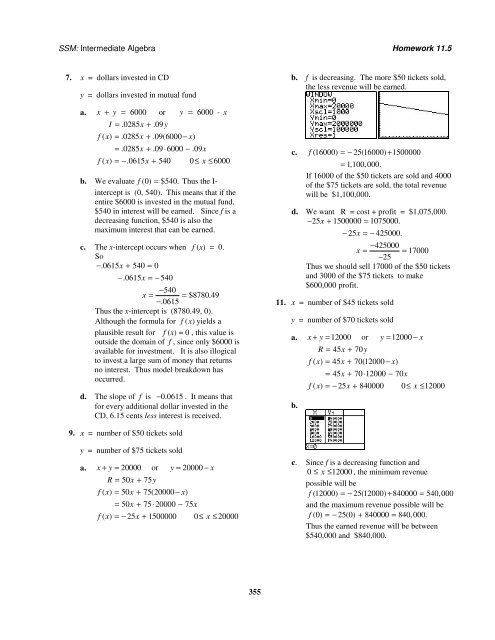Chapter 11 Additional Topics
Chapter 11 Additional Topics
Chapter 11 Additional Topics
You also want an ePaper? Increase the reach of your titles
YUMPU automatically turns print PDFs into web optimized ePapers that Google loves.
SSM: Intermediate Algebra Homework <strong>11</strong>.5<br />
7. x = dollars invested in CD<br />
y = dollars invested in mutual fund<br />
a. x + y = 6000 or y = 6000 - x<br />
I = .0285 x + .09y<br />
f ( x) = .0285 x + .09(6000 − x)<br />
= .0285 x + .09⋅6000 − .09x<br />
f ( x) = − .0615x + 540 0≤ x ≤6000<br />
b. We evaluate f (0) = $540. Thus the I-<br />
intercept is (0, 540). This means that if the<br />
entire $6000 is invested in the mutual fund,<br />
$540 in interest will be earned. Since f is a<br />
decreasing function, $540 is also the<br />
maximum interest that can be earned.<br />
c. The x-intercept occurs when f (x) = 0.<br />
So<br />
− .0615x<br />
+ 540 = 0<br />
− .0615x<br />
= − 540<br />
−540<br />
x = = $8780.49<br />
−.0615<br />
Thus the x-intercept is (8780.49, 0).<br />
Although the formula for f ( x)<br />
yields a<br />
plausible result for f (x) = 0 , this value is<br />
outside the domain of f , since only $6000 is<br />
available for investment. It is also illogical<br />
to invest a large sum of money that returns<br />
no interest. Thus model breakdown has<br />
occurred.<br />
d. The slope of f is − 0.0615 . It means that<br />
for every additional dollar invested in the<br />
CD, 6.15 cents less interest is received.<br />
b. f is decreasing. The more $50 tickets sold,<br />
the less revenue will be earned.<br />
c. f (16000) = − 25(16000) + 1500000<br />
= 1,100,000.<br />
If 16000 of the $50 tickets are sold and 4000<br />
of the $75 tickets are sold, the total revenue<br />
will be $1,100,000.<br />
d. We want R = cost + profit = $1,075,000.<br />
− 25x<br />
+ 1500000 = 1075000.<br />
− 25x<br />
= − 425000.<br />
−425000<br />
x = = 17000<br />
−25<br />
Thus we should sell 17000 of the $50 tickets<br />
and 3000 of the $75 tickets to make<br />
$600,000 profit.<br />
<strong>11</strong>. x = number of $45 tickets sold<br />
y = number of $70 tickets sold<br />
a. x + y = 12000 or y = 12000 − x<br />
b.<br />
R = 45x + 70y<br />
f ( x) = 45x + 70(12000 − x)<br />
= 45x<br />
+ 70⋅12000 − 70x<br />
f ( x) = − 25x + 840000 0≤ x ≤12000<br />
9. x = number of $50 tickets sold<br />
y = number of $75 tickets sold<br />
a. x + y = 20000 or y = 20000 − x<br />
R = 50x + 75y<br />
f ( x) = 50x + 75(20000 − x)<br />
= 50x<br />
+ 75⋅ 20000 − 75x<br />
f ( x) = − 25x + 1500000 0≤ x ≤ 20000<br />
c. Since f is a decreasing function and<br />
0 ≤ x ≤ 12000 , the minimum revenue<br />
possible will be<br />
f (12000) = − 25(12000) + 840000 = 540,000<br />
and the maximum revenue possible will be<br />
f (0) = − 25(0) + 840000 = 840,000.<br />
Thus the earned revenue will be between<br />
$540,000 and $840,000.<br />
355
















